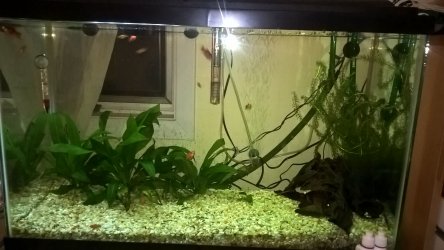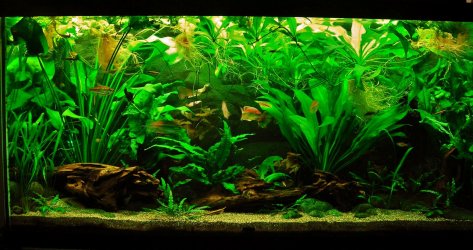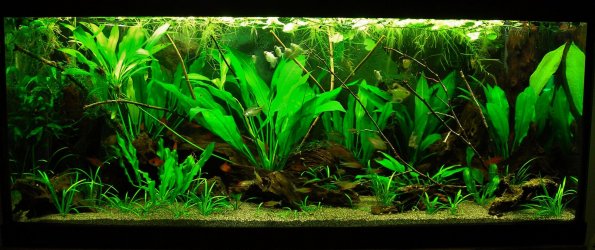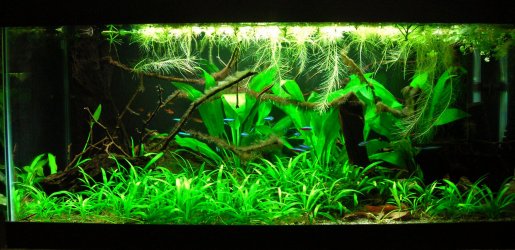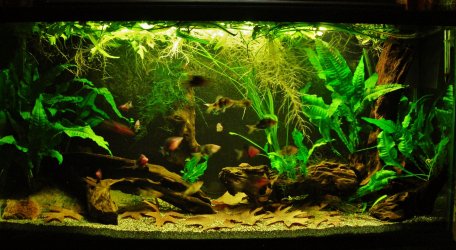Hello, I have a 29 gallon tank as seen attached. 3 Amazon swords, a really bad growing Anubis plant, and a clump of anacharis which I trim constantly. I am about to get stronger lights for the aquarium alongside a more modern heater, and I was just curious as to any suggestions for new plants I could possibly add to the tank? Ideally low lighting thus low co2 required carpeting plants or anything that will fill out the tank better would be appreciated, maybe high plants for the background for example.
You are using an out of date browser. It may not display this or other websites correctly.
You should upgrade or use an alternative browser.
You should upgrade or use an alternative browser.
Suggestions for Aquascaping?
- Thread starter BOBJOESIM
- Start date
April FOTM Photo Contest Starts Now!

🏆 Click to enter! 🏆
How long has this tank been running with the existing plants? I'm asking because the swords look fine, and if they have been growing well it would be risky to change the lighting. Stronger lighting is not necessarily better. It is best (when plants are doing well) to stay with what you have and build on that.
As for the background, a plain black tank background would do wonders. "Background" plants are not easy to deal with, because they tend to be in less direct light. Having a plain back background also makes the tank look deeper (front to back) and the back can disappear visually. Something that is not shiny works best; on my smaller tanks (40g and under) I use simple black construction paper.
Byron.
As for the background, a plain black tank background would do wonders. "Background" plants are not easy to deal with, because they tend to be in less direct light. Having a plain back background also makes the tank look deeper (front to back) and the back can disappear visually. Something that is not shiny works best; on my smaller tanks (40g and under) I use simple black construction paper.
Byron.
angelcraze
Fish Fanatic
- Joined
- Nov 23, 2016
- Messages
- 68
- Reaction score
- 31
I like dwarf sag for a carpeting plant with lower lighting. I also use stargrass to make a carpet in low light tanks, but it requires more trimming and replanting since it's a stem plant. But with root feeding plants, they may need additional substrate fertilizer, if you have only inert gravel. The stargrass will grow in just gravel and fish poop if the lighting is strong enough.
I think you might be able to get away with some type of vallisneria for the background. But you could also do easy fast growing stem plants and let them grow taller, like rotala rotundifolia. Just replant the tops in the front to create a tapering 'bush' or plant them in sections all in a staggering row.
I think you might be able to get away with some type of vallisneria for the background. But you could also do easy fast growing stem plants and let them grow taller, like rotala rotundifolia. Just replant the tops in the front to create a tapering 'bush' or plant them in sections all in a staggering row.
"Background" plants are not easy to deal with, because they tend to be in less direct light
I painted my 2 foot tanks sides and rear glass, the outside not the inside LOL.
Plants that tolerate lower light are great, You can use small suction cups to attach Anubias to the rear glass, Basically you could go nuts with Anubias like I did, Throw in a few tall plants in the back and it looks great.
While not to all tastes I prefer the jungle look. Surprisingly this is a low maintenance tank, water change 50% once a week, and I feed the Betta and shrimp, No ferts, Just plain old tap water and Easy Life Fluid Filter Media to treat the tap water.
This is my 2 foot mess.
http://www.fishforums.net/threads/betta-being-a-betta.442007/page-3
I also agree with Byron work with what you got when it comes to lighting.
How long has this tank been running with the existing plants? I'm asking because the swords look fine, and if they have been growing well it would be risky to change the lighting. Stronger lighting is not necessarily better. It is best (when plants are doing well) to stay with what you have and build on that.
As for the background, a plain black tank background would do wonders. "Background" plants are not easy to deal with, because they tend to be in less direct light. Having a plain back background also makes the tank look deeper (front to back) and the back can disappear visually. Something that is not shiny works best; on my smaller tanks (40g and under) I use simple black construction paper.
Byron.
It's been running for approximately 4 months, the swords have been growing nicely, but more in a bushy form instead of the tall leaves I was looking for. The tank is also next to a window, so there is some sunlight coming from there but it's mostly indirect because the angle is off and a house is infront. The reason I was thinking about adding more light was because most of the plants have been growing really slowly, even the anacharis which used to be exploding when I first bought it seems to be at 1 inch every 2 weeks. Also, the light I have currently is just one strip from the aqueon hood (the day light thing that comes with it), so I believe that I should add more lighting before adding more plants...(my Anubis is barely growing as well, and some plants I've bought within the last 2 months have also died or been stagnant for a while like dwarf hairgrass...which I was naïve enough to try without co2).
It's been running for approximately 4 months, the swords have been growing nicely, but more in a bushy form instead of the tall leaves I was looking for. The tank is also next to a window, so there is some sunlight coming from there but it's mostly indirect because the angle is off and a house is infront. The reason I was thinking about adding more light was because most of the plants have been growing really slowly, even the anacharis which used to be exploding when I first bought it seems to be at 1 inch every 2 weeks. Also, the light I have currently is just one strip from the aqueon hood (the day light thing that comes with it), so I believe that I should add more lighting before adding more plants...(my Anubis is barely growing as well, and some plants I've bought within the last 2 months have also died or been stagnant for a while like dwarf hairgrass...which I was naïve enough to try without co2).
Light intensity does affect most plants' growth habit. For example, swords will tend to be taller with less light, and shorter with brighter light, generally. This is because the leaves tend to grow closer to the light when it is less intense, but remain smaller and usually thicker with brighter light. So increasing the light intensity might not achieve taller swords.
Some plants will grow faster with brighter light. Light drives photosynthesis, and provided all required nutrients are available, plant growth will be maximum for the light, at least up to a point; one has to be careful not to exceed this level, as algae can easily become a nuisance if there is any imbalance of light/nutrients.
Anubias is a very slow growing plant that requires lower light than say swords and stem plants. I find it does best in partial shade, achieved by floating plants. In direct light, or too bright light, it is prone to brush algae. Java Fern does the same under too much light.
Four months is a reasonable period to assess plant growth and response to the conditions you are providing (light and nutrients). No mention has yet been made of plant additives, and I am not suggesting you need any (or any more if some is being added now), but any change in light will mean a change in nutrients too, as you must have a balance or algae will become troublesome and plant growth with or without algae could deteriorate.
It is interesting that just as fish are much more closely connected to their aquatic environment compared to terrestrial animals, aquatic plants are much more demanding than terrestrial. This is because of the unique properties of water and the impact this has on the fish's or plant's physiology and metabolism.
Is your lighting a fluorescent tube, or LED? IF fluorescent, what is the tube length, wattage and spectrum? The wattage and Kelvin (a number with a K suffix) might be printed on the tube, if not the packaging or instructions. You might get impressive benefits by just using a different tube. I have two 29g tanks in my fish room, with Aqueon fluorescent hoods holding one 24-inch T8 tube, and I have experimented with many tubes. Some will not work at all, while others result in thriving plants, though low and moderate light requiring species (such as those we have been talking about).
Byron.
The light is led, and I cant find any information online in regards to it's color temperature. And oh my, thank you for the informative response. Out of curiosity, if you do have any experience with it, if I were to dose CO2 in a tank to boost growth, lets say with either something like carpeting plants or just what I have already, would I need to continue dosing after the plants have grown to the size I want or may I just stop once I get the desired effect?Light intensity does affect most plants' growth habit. For example, swords will tend to be taller with less light, and shorter with brighter light, generally. This is because the leaves tend to grow closer to the light when it is less intense, but remain smaller and usually thicker with brighter light. So increasing the light intensity might not achieve taller swords.
Some plants will grow faster with brighter light. Light drives photosynthesis, and provided all required nutrients are available, plant growth will be maximum for the light, at least up to a point; one has to be careful not to exceed this level, as algae can easily become a nuisance if there is any imbalance of light/nutrients.
Anubias is a very slow growing plant that requires lower light than say swords and stem plants. I find it does best in partial shade, achieved by floating plants. In direct light, or too bright light, it is prone to brush algae. Java Fern does the same under too much light.
Four months is a reasonable period to assess plant growth and response to the conditions you are providing (light and nutrients). No mention has yet been made of plant additives, and I am not suggesting you need any (or any more if some is being added now), but any change in light will mean a change in nutrients too, as you must have a balance or algae will become troublesome and plant growth with or without algae could deteriorate.
It is interesting that just as fish are much more closely connected to their aquatic environment compared to terrestrial animals, aquatic plants are much more demanding than terrestrial. This is because of the unique properties of water and the impact this has on the fish's or plant's physiology and metabolism.
Is your lighting a fluorescent tube, or LED? IF fluorescent, what is the tube length, wattage and spectrum? The wattage and Kelvin (a number with a K suffix) might be printed on the tube, if not the packaging or instructions. You might get impressive benefits by just using a different tube. I have two 29g tanks in my fish room, with Aqueon fluorescent hoods holding one 24-inch T8 tube, and I have experimented with many tubes. Some will not work at all, while others result in thriving plants, though low and moderate light requiring species (such as those we have been talking about).
Byron.
The light is led, and I cant find any information online in regards to it's color temperature. And oh my, thank you for the informative response. Out of curiosity, if you do have any experience with it, if I were to dose CO2 in a tank to boost growth, lets say with either something like carpeting plants or just what I have already, would I need to continue dosing after the plants have grown to the size I want or may I just stop once I get the desired effect?
I would not consider CO2 here, since frankly you would not see much benefit for the expense and effort. And I can almost guarantee the light would have to be increased, and then the other nutrients. I'll explain a bit, as it is important to understand the whole picture. So often this or that store or whomever suggests "CO2 will fix everything" or similar, but it can make things very much worse.
Aquatic plants need a certain level of light intensity to drive photosynthesis, and each species is a bit different. We can group plants into some arbitrary groupings like high light, moderate light and low light, and this is not bad to work with. But in order for the plant to use the light intensity to photosynthesize, 17 nutrients have to be available (we're talking aquatic plants here obviously). Provided they are all present in sufficient quantities, the plants will photosynthesize full out. This stops when something is no longer sufficient, be it light or one or more nutrients. And just to add to the complexity, some nutrients if in excess can cause the plant to shut down assimilation of certain other nutrients. My point in this is that we have to be careful. An enclosed aquarium is a very different environment from nature.
With planted tanks we talk of high-tech down to low-tech or natural. The high tech uses the most artificial stimulants to push the plants, whereas the opposite end uses the very least and relies more on nature. I prefer the latter, or close to it, for a couple of reasons. First, the less we intervene with stimulants, the less risk. If we intend keeping fish in the tank, we must not lose sight of the fact that every additive is going to get inside the fish. Many who do high-tech systems have no fish in the tank, it is an aquatic garden. And there is much in between.
There is a fair bit of natural CO2 produced in a fish tank. Respiration of fish, plants and some bacteria produces CO2, but even more occurs from the breakdown of organics in the substrate, which is why we tend not to mess with the substrate very much. If you were to add CO2 to your present tank, you would within a short space of time have an explosion of algae, because the plants cannot use the CO2 without more light intensity and the other 16 nutrients. And the latter are probably in rather short supply. They come in with water changes, fish foods, and if needed fertilizers. But too much of any of these can trigger algae because it throws out the balance of light/nutrients. This is something that rarely occurs in nature because of the vastness of the system.
From what I see in the photos, I would say you are getting very good growth from the swords. We haven't discussed p[ant additives, and you might or might not benefit from say a comprehensive supplement. This is one that has everything (nearly), and is safer because there is less chance of upsetting the balance among the nutrients.
I have never used CO2, and have no intention to ever start, because it would take me way above the natural method I want, for the sake of my fish which are more important to me. But here are some photos of 4 of my tanks that may illustrate what is achievable with minimal effort. Once the light is settled, and then nutrients are in balance, the system basically takes care of itself, and that means much less chance of something going wrong and harming the plants or fish.
Byron.
Attachments
flchamp89
Fish Crazy
- Joined
- Dec 3, 2016
- Messages
- 338
- Reaction score
- 59
OP stated dose co2. So he referring to glut (excel).
Alot of people use flourish excel as a carbon and or algaecide. I use it at its reccomended dose. Like anything it is a tool. Do your homework as far as plants and inverts go as some are more sensitive than others.
Sent from my SAMSUNG-SM-G890A using Tapatalk
Alot of people use flourish excel as a carbon and or algaecide. I use it at its reccomended dose. Like anything it is a tool. Do your homework as far as plants and inverts go as some are more sensitive than others.
Sent from my SAMSUNG-SM-G890A using Tapatalk
SantaMonica
Fish Crazy
I prefer the jungle look. Surprisingly this is a low maintenance tank
It makes sense that letting everything grow, will give you a forest
Also as mentioned, without having to get into co2, you can get this naturally with more fish, and more feeding of them. The fast constant swimmers are the ones that respire the most co2 into the water, compared to more still ones.
angelcraze
Fish Fanatic
- Joined
- Nov 23, 2016
- Messages
- 68
- Reaction score
- 31
How long have those swords been in the tank for? They look good to me! They just look like young swords. In my low light tank with amazon swords, I added a root tab to each sword and they doubled in size (exploded with taller leaves) in the matter of two months.
Latest Discussions
- Replies
- 8
- Views
- 146
- Replies
- 12
- Views
- 150
trending
-
-
-
-
-
F-1 Angel... a bit nervous... it'll be my 1st F-1 fish...
- Started by Magnum Man
- Replies: 16
Staff online
-
emeraldkingModerator
-
GaryEModerator
Members online
Total: 515 (members: 10, guests: 505)

